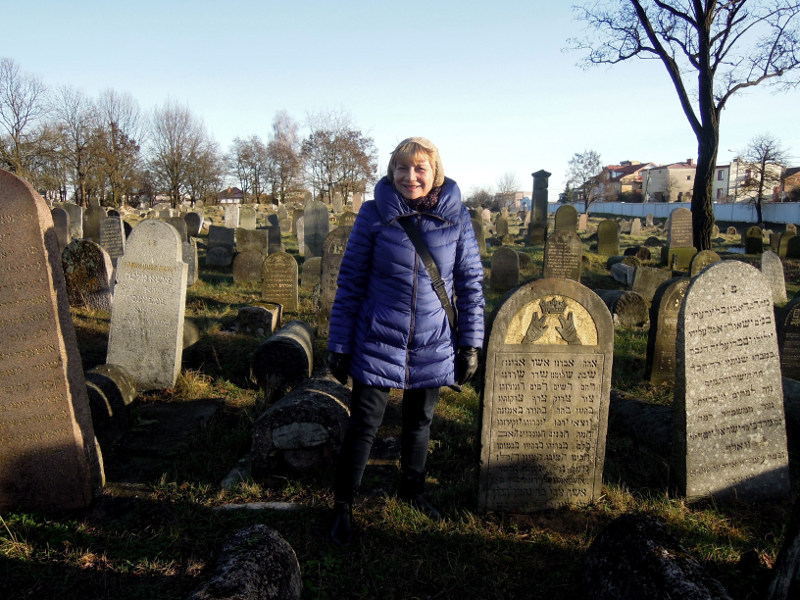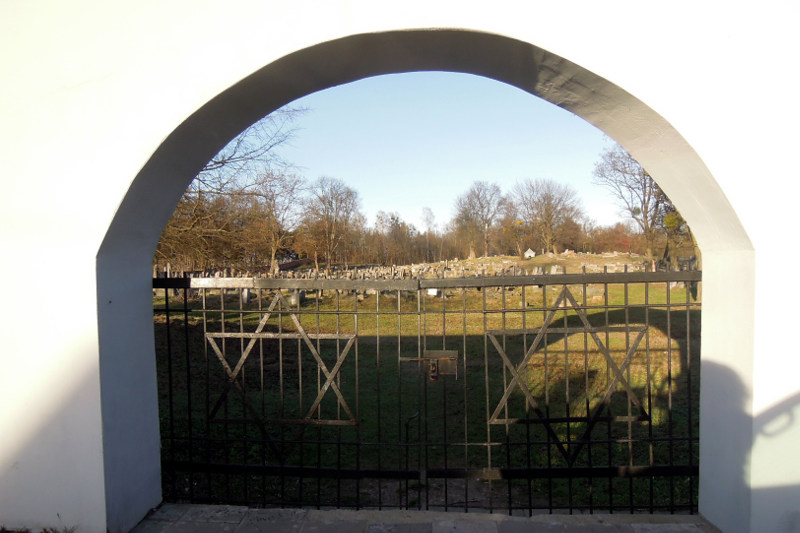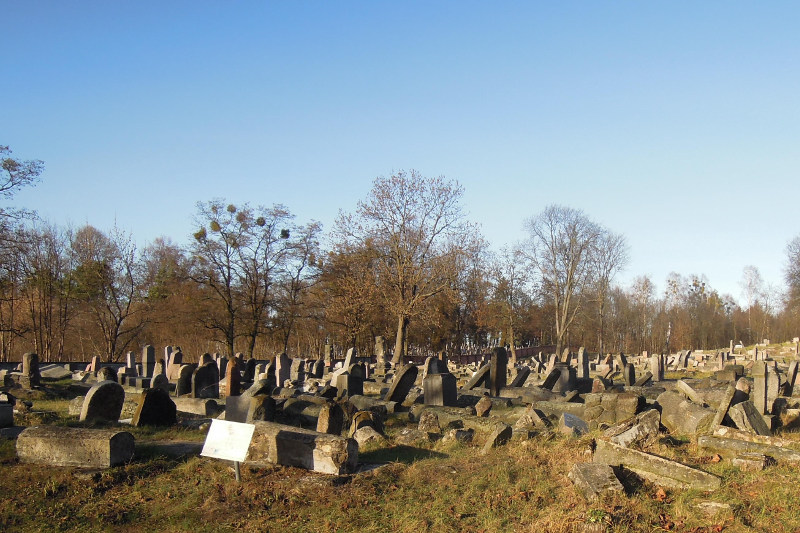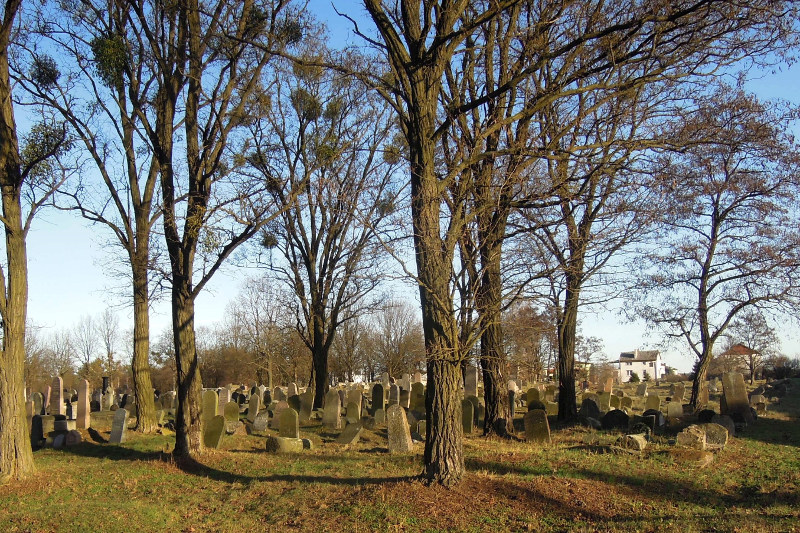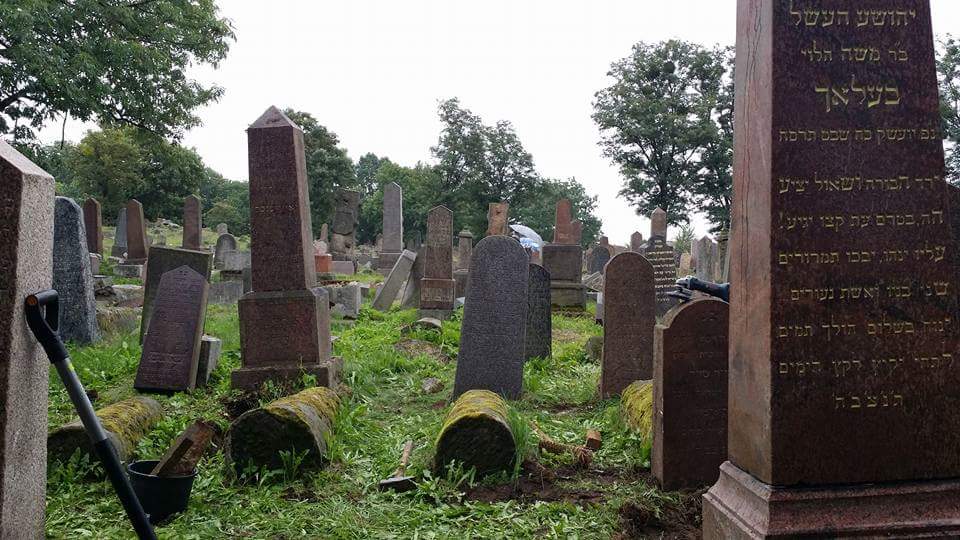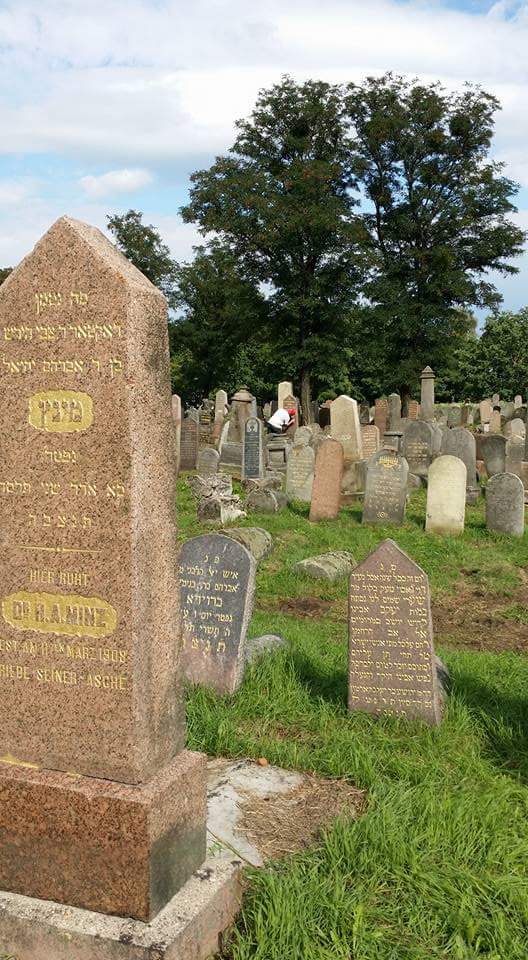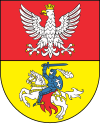
Alternate names: Białystok [Pol], Byalistok [Yid], Belostok [Rus], Belastok [Bel], Balstogė [Lith], Bjalistoka [Latv], Bialistok, Bielastok, Russian: Белосток. Belarusian: Беласток. ביאַליסטאָק-Yiddish. 53°08' N, 23°09' E. 1900 Jewish population: 47,783.
JOWBR burial list: Jewish Cemetery.
Yizkors: Der Bialystoker yisker-bukh (New York, 1982);
Bialystok; bilder album (New York, 1951);
Pinkes Bialystok; grunt-materyaln tsu der geshikte fun di yidn in Bialystok biz nokh der ershter velt-milkohme (New York, 1949-1950);
Bialystoker Stimme (New York, 1921-); Bóżnice Białostocczyzny (Białystok, 1992);
Jewish Bialystok and surroundings in Eastern Poland - A guide for yesterday and today (Ipswich, Mass., 1998).
Słownik Geograficzny Królestwa Polskiego (1880-1902), I, pp. 199-202: "Białystok". 1991 town population: 270,000. 2006 population was 294,830.
The Museum of Bialystok Jews [June 2014]
On June 27, 1941, the Nazis took Białystok and confined 56,000 Jewish residents in a ghetto after they surrounded the town square near the Great Synagogue (the largest wooden synagogue in Eastern Europe) and forced people from their homes into the street with some shoved against walls and shot. 800 men, women and children were lo
cked in the synagogue and burned to death. The Nazis and their collaborators threw grenades at homes. Flames from the synagogue spread to the entire square. About 3,000 Jews died that day. A clandestine underground resistance started. Some were jailed, some killed, and others deported to concentration camps. On August 15, 1943, the Białystok Ghetto Uprising began when several hundred Polish Jews started an armed struggle against troops liquidating the ghetto. The Nazis were run out by the Soviet army in September 1944. The city was part of the Byelorussian SSR until the Polish-Soviet border treaty in August 1945 gave Białystok and its surrounding area to Poland. Bialystok has extended, incorporating villages like Bialostoczek, Dziesieciny, Starosielce, Zawady, and Dojlidy Gorne.[Apribl 2009]
- BOOK: Gruber, Ruth Ellen. Jewish Heritage Travel A Guide to East-Central Europe . New York: John Wiley &Sons, Inc., 1992. P. 39-40.
- Shmulevitsh, Isak, Ribalovski, Shmuel A. Kronik ; Y. Shmulevitsh, redaktor. Byalistoker yizker bukh / redaktsie-kolegye, Y. Published: New York:
- BOOK: Aroysgegebn fun dem Byalistoker Tsenter, 1982. English and Yiddish. Title on added: The Bialystoker memorial book . Includes bibliographies. Available at U. of Florida
- BOOK: Wisniewski, Tomasz. Jewish Bialystok and Surrounds in Eastern Poland: A Guide for Yesterday and Today . Ipswich, Mass: Ipswich Press, 1998. ISBN 0-938864-22X.
CEMETERY: photos of the Jewish cemetery. Cemetery photos. [April 2009] Town website [August 2005]
- video [Sept 2015]
"The Bialystok Jewish Cemetery at Zabia and Proletariacks Streets is a public park; graves have been desecrated or simply covered over." Source: Freedman, Warren. World Guide for the Jewish Traveler . NY: E.P. Dutton Inc, 1984. Extracted by Bernard Kouchel, This email address is being protected from spambots. You need JavaScript enabled to view it.
Bialowieza District pre-WWII towns with Jewish population in Bialystok region in 1921: Chwalowo, Cichawola, Kolonia Hlubieniec, Izbice, Krynica, Krzyze, Masiewo, Panansiuki, Pieniazki, Popielewo, Rowbick, Suchowola, and Zastawa. Bialystok District pre-WWII towns with Jewish population in Bialystok region in 1921: Jakubiewo, Kamienny Brod, Laskowiec, Mieleszki, Zubole.
MASS GRAVES: The Bialystoker Memorial Book: Bialystok Martyrs of the 1906 Pogrom-Bagnowke Jewish Cemetery in Bialystok "All victims of this pogrom were buried in a mass grave, in a prestigious place within the the old Jewish cemetery in Bialystok. Above this grave, a tall monument was erected, inscribed with a special epitaph in Hebrew, by the well-known poet Zalman Sznejur. The large monument near the mass grave of the pogrom victims stood for decades in the Bagnowke Jewish Cemetery in Bialystok. It reminded many of three horrible days for Jews in Bialystok in early June 1." Listing information from the book 906 [sic]. After World War II, the Poles vandalized this stately headstone, cutting it into three pieces and discarding it near the outskirts of the cemetery. Listing of names and ages available under Bagnowke Jewish Cemetery. The Bialystok Jewish Cemetery at Zabia and Proletariacka Streets is a public park; graves have been desecrated or simply covered over." [Source?]
A mass grave was not reported in Wisniewski's survey III below for the U.S. Commission for the Preservation of America's Heritage Abroad. According to Wisniewski in Jewish Bialystok , p. 60: in "Pietrasze", a forest on N outskirts of Bialystok "entered by walking on a dirt road about one-half mile east of Highway 18" is the mass grave and a "small memorial park [that] marks the forest location where German soldiers murdered ... between 3,000 and 4,000 Jewish men, women and boys on the 3rd and 11-13th of July 1941." (p. 61) [ESR-September 2000]
Also unreported to the Commission was "Grabowka: At the eastern edge of Bialystok, reached from Highway 66 towards Bobrowniki, a monument commemorates another forest location where a mass execution of Jews as well as Christians took place." [ESR-September 2000]
article about Bialystok gravestones. [May 2010]
BIALYSTOK I US Commission No. POCE00099
The cemetery is at ulica Wschodnia, Dzielnica Banowka.
- Town: 1. Urzad Miejski [Municipal Office] B-Stok., ulica Slonimska 1, tel. 44-93-25; 2. Prezydent Miasta, B-stok, ulica Slonimska 1, tel. 41-11-25; and 3. Archiwum Panstwowe, Rynek Kosciuszki 4, tel. 43-55-06 and 43-55-03. Local: Wydziall Gospodarki Komunalnej, Mieszkaniowej Urzedu Miejskiego, Bialystok, ulica Slonimska 1, tel. 41-14-04.
- Regional: Wojewodzki Konserwator Zabytkow, Dojlidy Frabryczne 23, tel. 41-23-32.
- Interested: 1. Szkola Post. Nr. 8, Bialystok, ulica Jewsienna 8, tel. 75-48-74; and 2. Joanna Tyszko, Biuro Badan i Dokumentacji Zabytkow, B-stok, ulica Dojlidy Fabr. 23, tel. 41-21-91.
- Caretaker with key: Jefim Nachimowicz, Bialystok, ul Poleska 11, tel. 75-38-09.
- Biaystoker Center New York, 228 E. Broadway, NY 10002, USA and Bialystoker Center, Israel, Yehud, Hagetaot 7.
The earliest known Jewish community was 1692 or 1711; 1931 Jewish population was 39,165 (Polish needs translation) ["na raczna liczbe mieszk": 91, 207]. Noteworthy historical events: 1. Polowa 18th century-nadanie przywilejow dla zydow, przez Jana Klemensa Branickiego; 2. Koniec 19th cenetery, wplyw Koncepcsi syjonistycznych reprezentowanyck przez Rabina Szmuela Momilewera, Dr. Josifa Chazanowicza, poczatkujacy emigracje; and 3. pogrom in 1906. Living here were Ludwik Zamenhof, Dr. Josif Chazanowicz, Rabbi Szmuel Mohilewer, Chaim Zelig Slonimski, Abraham Samuel Herszberg, Jacob Szapiro, Icchak Szamir, Leon Pines. Rabbi Gedalij Rozenman, Ludwik Zamenhof, and Icchak Malmed are buried there. The Jewish cemetery was established officially in 1892 [Polish needs translation] rok najstarszy zlokalizowany nagrobek 1876. The last known Jewish burial was in 1969. The Jewish community was Chasydzi z Kocka, Slbonimia, Stolina mieszkajacy w Bialymstoku and Sepharfic, Conservative, and Reform. Surrounding villages that used this cemetery: Suprasl, Wasilkow, Suraz, Lapy, and Starosielce, and Okoliczne Wsie, all 10 to 25 km. away. The cemetery is landmarked: "dokumentacja cmentarza znajduje sie w trakcie opracowania, czesc opracowana znajduje sio, w biurze badan i Dokumentacji Zabytkow w. B-stocki". The suburban flat land, separate but near other cemeteries, has no sign but has Jewish symbols on gate or wall. Reached by turning directly off a public road, access is open to all via a broken masonry wall and a locking gate. Size of cemetery before WWII was 125,000 square meter and is 100,000 square meters now. More than 5000 gravestones in cemetery, 500 in original locations and 50%-75% toppled or broken, date from 1876. The cemetery is divided into special sections (no details given). The marble, granite, limestone, sandstone, slate, and concrete rough stones/boulders, flat shaped stones, finely smoothed and inscribed stones, and sculpted monuments have Hebrew, Yiddish, Polish, German and Russian inscriptions. Some have traces of painting on their surfaces. The cemetery contains special memorial monuments to pogrom victims. Within the limits of the cemetery are no structures or known mass graves. The municipality now owns the property used for Jewish cemetery and recreation. Properties adjacent are residential and residential. The cemetery size is smaller than in 1941 because an anti-Semitic political campaign in 1968. Frequently, organized Jewish tour/pilgrimage groups, organized individual tours, private visitors, and local residents visit. The cemetery was not vandalized in the last ten years. Past maintenance: 1971 "zlikwidowano cmentarz. ustawiono skromy obelisk, ktory otaczny jest opieka" by local/municipal authorities in 1985, ogrodzenie zelazna balustradka. Care now is occasional clearing or cleaning by authorities and regular caretaker paid for by contributions from visitors. Vandalism is a slight threat. Vegetation overgrowth is a seasonal problem, preventing access. Tomasz Wisniewski visited site on 30 July 1991, using the following documentation: 1. Teczka Dotyczaca, Cmentarza Gettowego. ZiH Warszawa; and 2. Tomaz Wisniewski, Cmentarze Zydowskie w Bialymstoku w: Studia podlaskie Tom II-Bialystok 1989. He interviewed Dr. Anatol Leszcynski, W-WA ul Dantyszka 2/15 tel 252- 662, and other persons mentioned above.
NOTE: According to Jewish Bialystok, Wisniewski [who completed these surveys] states that the Wschodnia Street cemetery is "the largest Jewish cemetery in Northern Poland." He also adds that the size is 12-hectare (about 30 acres) and that about 7,000 gravestones remain of the possibly 40,000 standing before "Germans removed them to build sidewalks, roads, and even buildings..." (p. 55) This contradicts the information he supplied above. Catholic and Russian Orthodox cemeteries adjoin. He notes the first burial as that of Fruma bat Jehuda Lejb in 1892 or 5652, again contradicting his survey that reports the first burial as 1876. He states that the last burial was 1969. He notes a conical roofed ohel covering the grave of Rabbi Chaim Herce Halpern, son of Rabbi Lipe Lepele, Chief Rabbi of Bialystok for over fifty years until 1919. This ohel donated by Bialystok Jews in New York was unreported in his survey above. He also mentions a black marble pillar commemorating the 1906 pogrom against Jews. See Bialystok yizkor for more information. http://www.jewishgen.org/Yizkor [ESR-September 2000]
UPDATE: There is indeed an ohel on the grave of Chaim Naftali Hertz Halperin that has been vandalized. Only the actual concrete building remains, but inside no gravestone. A faded inscription of the donation of the NY congregation can still be seen. The outline of his son-in-law's gravestone can be seen connected to the grave. Source: Ariel Fuss, Jerusalem, Isreal. This email address is being protected from spambots. You need JavaScript enabled to view it. [August 2003]
BIALYSTOK II: US Commission No. POCE000100
Location of cemetery: ulica Zabia.
- Regional: "Biruna" Frabryka Wyrobow Runowyck, B-stok, ulica Swietojanska 15, tel. 265-35; and Szyja Bortnowski, Bialystok, ulica Zabia. No key, but the two above are also listed as caretakers.
- Interested: Zydowski Instytut Historyczny Warzawa, ul Tlomackie 3315, and Dr. Anatol Leszczynski, Warszawa, ulica Dantyszka 2/15 tel. 252-662.
Noteworthy historical events: 1. Polowa 18th century-nadanie przywilejow dla zydow, przez Jana Klemensa Branickiego; 2. Zalozenie Getta Zydowskiego Przez Okupanta Niemieckiego 1 August 1941; and 3. Zaglada Getta 16 August 1943. Zginelo ok. 50,000 Zydow Bialostockich. The date Jewish cemetery was established August 1941. Buried in this cemetery are Dr. Aleksander Rajgrodzki (Vice President of the town), Pejsach Kaplan, and Abraham Samuel Herszberg. Date of the last known Progressive/Reform and zydi niepraktykujacy Jewish burial: 1948. Other towns and villages that used this cemetery: Jasionowka, Bransk, Zabludow, Krynki, Wasilkow, Suprasl, and Lapy, all 10 to 50 km away. The cemetery is land-marked: "jest wpisany do rejestru Pomnikow Walki i Meczenstwa". The isolated urban flat land has a sign in Polish mentioning Jews and the Holocaust. Reached by turning directly off a public road, access is open to all. The cemetery has a broken masonry wall and no gate. Size of cemetery was 1 hectare (10,000 sq. meters.) in 1948 and 55 sq. meters in 1980. One 1941 obelisk is in the cemetery. The sandstone tombstone/memorial marker inscribed in Polish is a finely smoothed and inscribed stone with iron decoration or lettering and a metal fence. The cemetery contains special memorial monuments to Holocaust victims and Jewish soldiers. The cemetery contains marked mass graves. Within the limits of the cemetery is an ohel. The municipality owns the property, now used for Jewish cemetery only. Properties adjacent are residential and Catholic cemetery. The cemetery size is smaller than in 1939 because of a housing development. Occasionally, organized Jewish tour/pilgrimage groups, organized individual tours, private visitors, and local residents visit. The cemetery was vandalized during WWII and occasionally now. Local/ municipal authorities and the Bialystoker Center in New York (USA) re-erected stones, patched broken stones, cleared vegetation, and fixed wall and gate from 1981-1991. Biaystoker Center New York, 228 E. Broadway, NY 10002, USA pays the caretaker. Vandalism is a moderate threat. Incompatible nearby development is a serious threat. Private property is taking over the cemetery property. Security and weather erosion are slight threats.
Tomasz Wisniewski completed survey using the following documentation: 1. Karty evidencyjne Nagrobkow Zydowskich Cmentarza-Opracowala J. Tyszko, Tlumaczyl T. Fedorowicz, BBiDZ Bialystok; 2. Bialystok Cmentarz Zydowski, Studium Historyczne opr. B. Tomecka pk z B-stok 1985; 3. w. Tomacz Wisniewski, Cmentarze Zydowskie w Bialymstoku w: Studia podlaskie Tom II-Bialystok 1989; and 4. A.S. Herszberg, Pinkos Bialystok, New York 1949-50 TI/II. Wisniewski and Iwona Plichta-Wisniewska visited the site between 1984 and 1991.
NOTE: In Jewish Bialystok , Wisniewski reports that a small park surrounded by an iron fence is a twelve-foot monument with Mogen David "commemorating the 3,000 leaders and fighters" [or 3,500] murdered in the Bialystok ghetto and tended by the Chevra Kadisha. He adds that "this Bialystok cemetery was the only ghetto cemetery in Europe." (p. 57) Also called the Ghetto cemetery, this site was used 1941-1971 having been restored by returning Jews after WWII with "a wall, several obelisks and a mausoleum..." (p. 58) In 1971, the cemetery was destroyed by vandals. All that remained was the small monument and a wall fragment. (p. 58) In 1993, the obelisk was dedicated. [ESR-September 2000]
BIALYSTOK III: US Commission No. POCE000140
The cemetery was located in what is now in the central park on Kalinowsiego St. The cemetery does not exist. This cemetery was established around 1760 with the last burial around 1890 oraz 1941 (lipiec). Suprasl, Starosielce, and Lapy, up to 25 km away, used this cemetery. The cemetery was around 2.0 hectares before WWII. One gravestone has been dug up. The rest are covered with a layer of soil from which the park was established. Reportedly, the oldest gravestone was 1767. The cemetery was vandalized during WWII. Tomasz Wisniewski visited the site in 1990 and 1991 and completed the survey.
- ul Bema cemetery used from 1841-1890 and completely destroyed after WWII is now a market place. Source: Miriam Weiner
- ul Sosnowa is now a park. This was a Jewish cholbera cemetery. Source: Miriam Weiner
Information, maps, and inscription translations about these cemeteries is available from State Agency for Protection of Monuments in Bialystok, 23 Dojlidy St. Bialystok. Telephone/FAX: 412332
[UPDATE] Tour cemetery by drone [January 2015]
[UPDATE] Folk Art on a Jewish Cemetery in Poland [April 2015]
[UPDATE] Will the Area of Jewish Cemetery in Bialystok be Developed? [Sept 2015]
[UPDATE] City of Bialystok Allows High-Rise on Jewish Cemetery Site [Oct 2015]
bPhotos courtesy of This email address is being protected from spambots. You need JavaScript enabled to view it. [January 2016]
[UPDATE] Fund appeal - Restoration of Bialystok Cemetery Phase II (Interesting video on page, and this particular funding appeal page is complete and closed) ([May 2017]
[UPDATE] Fund appeal - Restoration of Bialystok Cemetery for Summer 2018 work [November 2017]
Photos from Facebook [August 2016]
[UPDATE] [Update 2020] Bagnowka Jewish Cemetery, the last and largest Jewish cemetery established in (now) NE Bialystok, functioned from 1892-1969 with some concurrent burials with the Old Rabbinic Cemetery at the city center during its first decade of operation. Once 40 acres with the potential of 35,000 burials, 30 acres and possibly 5-6000 tombstones remain. At present, nearly 3400 inscriptions have been documented, the earliest dates to 1891, the most recent to 1952. Ongoing restoration by the US-based Bialystok Cemetery Restoration Project (BJCP) (www.

